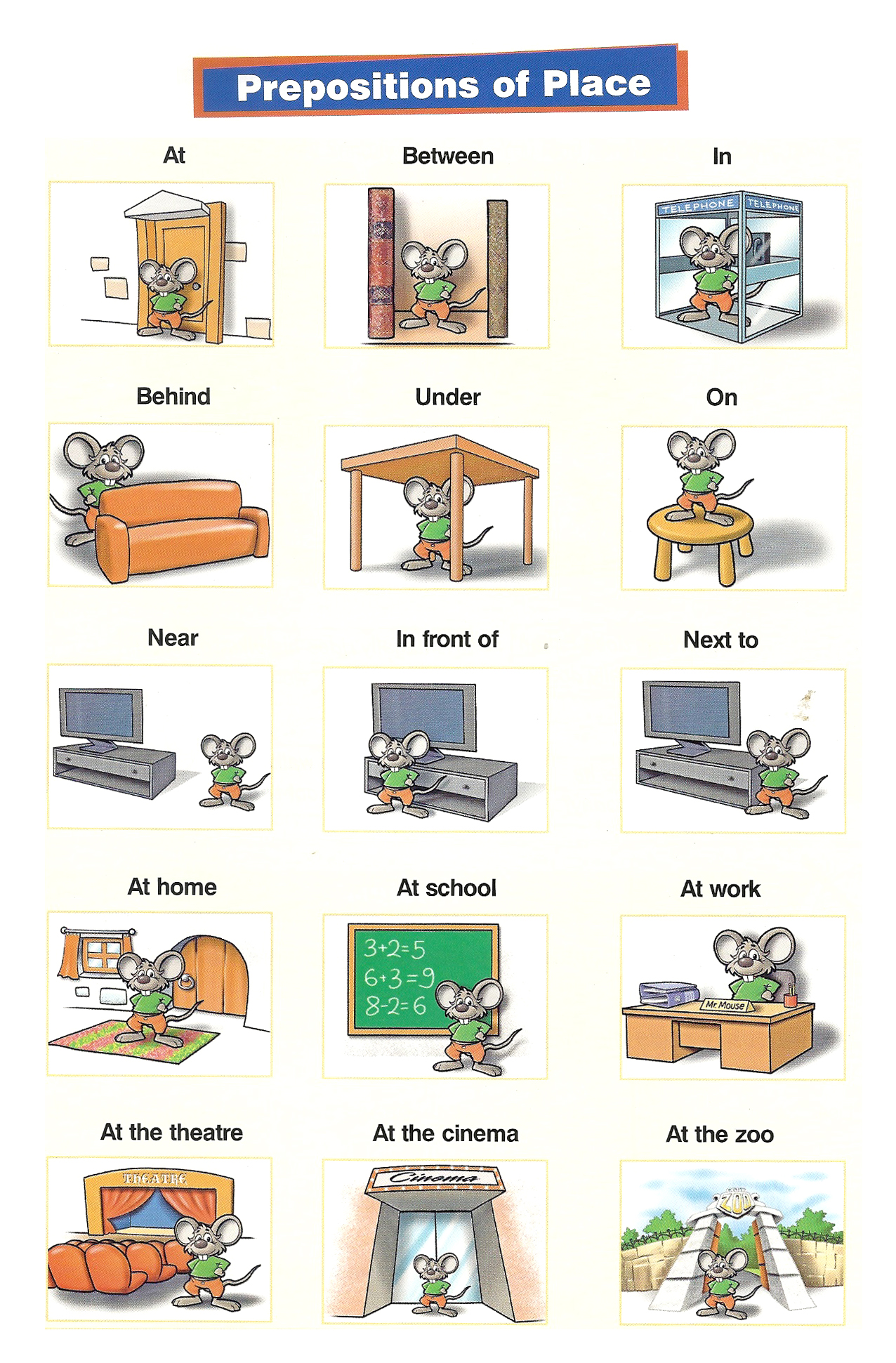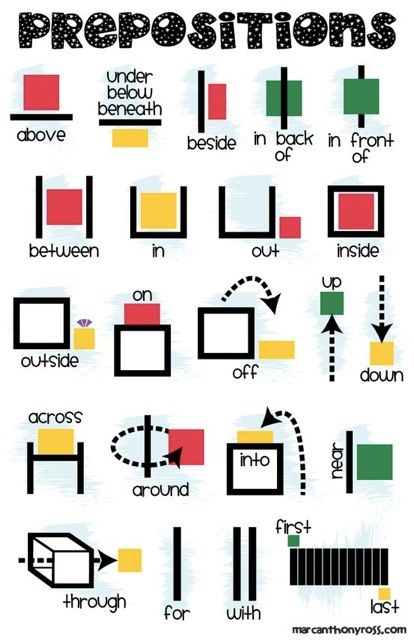Dear students,
As I told you before this is a post about prepositions. A lot of ESL students have problems using preposition. That's why I have decided to write this post for you.
Irena
Yesterday we learned some prepositions with place. Today I'd like you to review everything and practice these prepositions. Here are some videos. Please, watch them and review the prepositions on, in and at.
First, watch these videos. There are 3 parts of it, and all of them are about prepositions.
For Spanish speaking students there is a good video about prepositions. So, Hispanic students, please watch it. It will help you to understand prepositions better.
There is some more information about prepositions here. Please, use this link to get there.Just click on blue words.
Now, here are some exercises you can practice to improve your usage of prepositions.
To understand the meaning of the prepositions and see some examples of them, look at this box.
English
Preposition
| Usage | Examples |
| above | higher than something | a photo above the sofa |
| across | getting to the other side getting over something getting to the other side | walking across a road walking across a bridge swimming across the river |
| after | one follows the other | run after something or someone after you sir |
| among | in a group | among a crowd of people |
| around | in a circular | sitting around, around a campfire |
| at | meaning next to, by an object for table for events place where you are to do something typical (watch a film, study, work) | at the tree, at the bus stop at the table at a festival, at a birthday party at the cinema, at school, at work |
| behind | at the back of | The house behind the cinema |
| below | lower than something else but above ground | Fish swim below the surface of the water. |
| between | on each side | Your nose is between your two ears. |
| by, next to, beside | left or right of somebody or something | He is standing by / next to / beside her. |
| close to | near | Stay close to me so you don’t get lost. |
| down | from high to low | I drove down the hill. |
| from | in the sense of where from/ the place where it starts | A fish from the river. I’m from Ireland. |
| in | room, building, street, town, country book, paper etc. car, taxi picture, world | in the kitchen, in London in the book, in the paper in the car, in a taxi in a picture, in the world |
| in front of | further forward than another person or thing | He is standing in front of the car. |
| inside | in something/opposite of outside | The toy is inside the box. |
| into | enter a room / a building | go into the kitchen / the house |
| near | close to | Stay near me so you don’t get lost. |
| off | away from something | The baby threw his dinner off the table. |
| on | attached for a place with a river being on a surface for a certain side (left, right) for a floor in a house for public transport for television, radio | the picture on the wall Paris is on the Seine. on the table on the left, on the right on the second floor on the bus, on a plane on TV, on the radio |
| onto | movement to the top of something | The cat jumped onto the table. |
| opposite | on the other side | Our house is opposite the cinema. |
| out of | leaving something | She got out of the swimming pool because she was very cold. |
| outside | out of something/the opposite of inside | Put the cat outside before you go to bed. |
| over | covered by something else meaning more than getting to the other side (also across) overcoming an obstacle above something | Wear a cardigan over your blouse. over 18 years old walk over the bridge/walk across the bridge climb over a wall The cat jumped over the table. |
| past | going near something or someone | It was raining but she drove past me |
| around | in a circular | sitting around/around a campfire |
| through | something with limits on top, bottom and the sides going inside something from one side to another from the beginning to the end of something connected by telephone because of someone or something | She escaped through the hole in the wall. We went through the tunnel. We traveled through the night. I tried to phone you but I couldn’t get through. He got that job through her mother as she is the supervisor. |
| to | movement to person or building movement to a place or country for bed | go to her, go to the shop go to London / Ireland go to bed |
| towards | movement in the direction of something (but not necessary directly to it) | We walked towards the city. |
| under | on the ground, lower than (or covered by) something else | the shoe is under the bed |
| up | from low to high | I climbed up the mountain. |
Here is some more information about prepositions AT, IN TO and ON.
General Information: AT and ON
We use AT for a point.
We use ON or a surface.
at the window
at the entrance
at the door on the wall
on the ceiling
on the floor
on a page
at the end of the street
at the station
at the top on a cover
Bill is waiting for you at the bus stop.
Have you seen the notice on the notice board?
General Information: IN
We use IN for an enclosed space
in the garden
in the house
in London
in the water
in her bag
in a row
in a town
There is nobody in the room.
She lives in a small village.
Special Information: AT
We say that someone is at an event.
We say at with buildings when we say where the event (film, concert,...) takes place:
at a party
at a pop concert
at a conference
at a meeting
Where were you yesterday? At the cinema.
Tom is at a party.
The meeting took place at the headquarters.
We say at someone's house.
We say at for a place which is a part of our journey.
We were at Bill's house last Thursday.
We stopped at a very nice village.
Does the train stop at Nashville?
General Information: ON
We use on with small islands.
We say that a place is on the coast / on a river / on a road:
She spent her holiday on a small island. London is on the river Thames.
Portsmouth is on the south coast of England.
General Information: IN
We say in when we talk about a building itself.
We usually say in with towns and villages:
The rooms in Tom's house are small.
His parents live in New York.
Note these expressions: AT
at home
at work
at school
at university
at college
at the station
at an airport
at the seaside
at sea (on a voyage)
at reception
at the corner of a street
at the back / front of a building / cinema / group of people, etc.
arrive at with other places or events
Note these expressions: IN
in the newspaper
in bed
in hospital
in prison
in the street
in the sky
in an armchair (sit)
in a photograph
in a picture
in a mirror
in the corner of a room
in the back / front of a car
arrive in a country or town
Note these expressions: ON
on a farm
on the left
on the right
on the ground floor
on the first, second,... floor
on the way
on the chair (sit)
on the radio
on television
on a horse
on the corner of a street
on the back / front of a letter / piece of paper etc.
TO, INTO, BY
We say go / come / travel / fly / walk / return / drive / have been etc. TO a place or event.
We say go into / come INTO etc. = enter a room / building etc.
Last year we flew to London.
We went to work at seven.
He opened the door and went into the room.
BY
We say by to say how we travel.
We went to Paris BY plane.
I usually go to work by bike / by car / by underground / by bus
but (please, pay attention!)
we say: ON foot
we cannot use BY if you say my car / the train / a taxi
Then use IN for taxis and cars.
Then use ON for bike / and public transport.
Here there is some useful information about this subject. Please, read carefully.
Here are some more Exercises. Click on them and do, please.
Ex. 1
Ex. 2
Ex. 3
Ex. 4
Ex. 5
Here are some more prepositions - Prepositions of Place. Please, look at the pictures and try to understand their meaning. Under each of the pictures there are some examples - a question and answers. Read carefully.
Where is the ball?
1. It's in the box.
2. It's on the box.
3. It's under (or below) the box.
4. It's next to (or beside) the box.
5. It's behind (or in back of) the ball.
6. It's in front of the box.
7. It's between the boxes.
Where is the mouse?
1. The mouse is under (or below) the box.
2. The mouse is over (or above) the box.
3. The mouse is in (or inside) the box.
4. The mouse is on the box.
5. The mouse is in front of the box.
6. The mouse is behind (or in back of)the box.
7. The mouse is next to (or beside) the box.
To make the picture bigger (or larger), please, click on it. Look at all additional prepositions and write sentences with each of them.
Hope, you've learned all of these prepositions!
Check yourselves.
Check yourselves.
Good luck!













